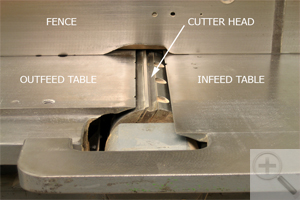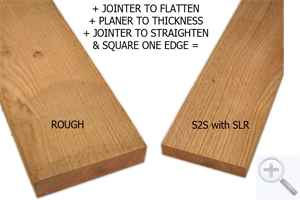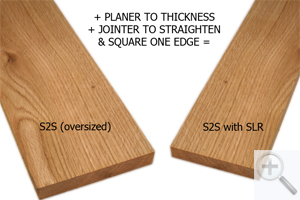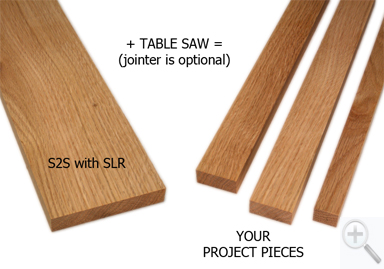Beginning woodworkers all ask this fundamental question: What is the difference between a jointer and a planer?
The answer is simple, a lot! Is there such a thing as a Jointer Planer? No!
So, what is the difference?
Each machine does a completely different surfacing operation.
A jointer flattens a face or straightens and squares an edge, and a planer thicknesses wood.
Whether you need one, the other, or both can quickly be answered by knowing how they work, what they do, and how much wood surface preparation you pay your lumberyard to do. And you could be a great woodworker without either machine. They are just time savers. Heck, you could use hand planes!
You need to convert your wood stock to usable pieces for your projects. A wood jointer and a planer will help you get there.
- What a Jointer Does & How It Works
- What a Planer Does & How It Works
- Different Levels of Lumberyard-Produced Surface Preparation
What a Jointer Does & How It Works
A jointer makes the face of a warped, twisted, or bowed board flat. After your boards are flat, the jointer can be used to straighten square edges (guard removed for photo).
There’s an infeed table and an outfeed table. The tables are aligned in the same plane. A cutter head with knives is mounted between the tables, and its cutting circle (tops of the knives) is aligned flush with the outfeed table.
The infeed table is lowered to a depth equal to the wood you want to remove. Passing a board across the running machine (with the guard in place) removes the wood, and the cut portion of the board is then supported on the outfeed table. A fence is used as a guide when flattening a face and as a support when jointing board edges. The fence is adjustable for different angles, typically up to 45 degrees.
WWGOA does offer instructional videos on how to use a jointer. Also, be sure to see our guide on how to master the jointer.
What a Planer Does & How It Works
A planer is used to make a board that’s been joined flat equal thickness from end to end. Mechanically, it’s more complicated than a jointer, but functionally it’s simpler.
A flattened board is placed on the planer table (bed) and pushed in. The machine’s feed roller grabs the board, pulls it through, and passes a rotating cutter headset above the bed, which removes wood. The distance the bed is set from the cutter head is the resulting thickness.
All planers have limits to how much wood they can remove in one pass, so achieving your finished thickness will likely require multiple passes.
Want to see a planer in action? Check out this unique video that offers an inside view of a wood planer.
Different Levels of Lumberyard-Produced Surface Preparation
Your lumberyard can only do some or all of your required surface preparation for the boards you purchase. The more they do, the more it costs, and the less control you have.
You could take this to the extreme, give them a cut list, and have them size all the pieces, but you’d go broke and have no fun woodworking. I’ll start by telling you how both machines are used to surface rough lumber and then give three more scenarios where your lumberyard does increasingly more of the work for you.
Rough
I buy my lumber rough (no surfacing), or surfaced hit & miss, which is how almost all the lumber I buy today comes. That removes 1/16″ and planes the wood, so it’s easy to see the grain and color.
The pieces I need for my projects are “inside” the boards I buy, and I have to machine the boards to make my pieces. I have much greater control over the wood’s shape and flatness when I machine a rough-cut board before using it in my project. One thing is for sure with surfaced wood; it will not be the same size and shape tomorrow.
Sizing rough lumber requires a jointer to flatten one face and a planer to cut the thickness. To cut the width, you use a jointer to square and straighten one edge and then rip the width on a table saw. I rip my boards 1/32″ wide, and then joint off the last 1/32″.
For more helpful tips, read my easy-to-follow guide: 9 Steps to Sizing Rough Lumber.
Surfaced Two Sides (oversized)- S2S.
Example: You ask your lumberyard to surface your 4/4 boards to 13/16″ even though you know you will eventually use them as 3/4″ thick boards. They surface the boards using a doubled-head planer that cuts both faces simultaneously and does a pretty good job flattening.
Surfacing this way can save you a lot of time. Then just before using your boards in your project, you will “kiss” the boards down to 3/4″ to clean up any rough surfaces left from the lumberyard machining, remove any dirt and oxidation that might have accumulated over time, and provide a fresh surface, which is critical for gluing. With this type of surfacing, you’ll need a planer for final thickness-ing and a jointer to straighten edges.
Surfaced Two Sides (final thickness)- S2S.
All is the same as above, but this time your lumberyard surfaces your boards to their final thickness.
All you need now is a jointer to straighten edges.
S2S with Straight Line Rip – SLR.
All is the same as S2S, but this time your lumberyard cuts one edge of every board straight and square.
You can now manage without either machine, but having a jointer to remove saw marks and smooth edges is nice.
Think your planer isn’t big enough? Check out these tricks for using a small planer and watch this video on how to get the most out of smaller planer.
Conclusion
Remember, it’s not Jointer Planer. A jointer can make a board’s face and edge straight and true. A planer makes your boards uniform in thickness, with two parallel faces. The operations are different between the two machines.
Owning both machines gives you the greatest control over the flatness and smoothness of the wood you use in your projects. My jointer is a monster at 12-in. wide and 84-in. long. It’s nice for flattening long and wide boards, but it may be overkill if your projects are small. My planer is 13-in. wide, making it the perfect companion to my wide jointer.
All Photos By Author





Question. If I want to make an edge grain cutting board, would it be OK to joint both faces flat for glue up with a jointer, or do I still need to ensure both faces are parallel with a planer? I think for the initial cuts and glue up having each face flat is sufficient,but want to be sure I am not creating any issues by not using a planer. Most of my boards are 4 inches wide or less.
Hello. A good quality combination machine can serve both purposes. For example, this unit is known to be good at both jointing and planing: https://amzn.to/36LpXdT . Also, this one is very good at both: https://www.felder-group.com/us-us/products/jointer-planers-jointersplaners/jointer-planer-a3-41.html I would be wary of the benchtop units that are designed to serve both, however, as the jointer tends to be compromised on lower priced products. So, if you have a good quality machine that serves both functions, then the question becomes whether it is worth it to you to save the floor space in exchange for spending more time doing the switchover. Typically a good quality combination machine is not cheaper than buying an individual jointer and planer, so the additional value is in the floor space that it saves. My preference is to have a dedicated jointer and planer, but if space is tight and you're willing to spend some time swapping back and forth, then a combination machine might be a good choice for you. Thanks Paul Woodworkers Guild of America
Jointer & Planer explained the best I've ever heard. Great job!
Yes, there really is a combination jointer/planer https://www.ebay.com/p/JET-JJP8BT-8-Electric-Jointer-Planer/710152681?iid=392276041705
Thank you. This a question i have been asking myself as i plan on a router shortly.
Good article! I always used the jointer first in order to get a perfectly straight edge, because It didn’t matter what process came next. Thanks for the post!
There is indeed such a thing as a jointer/planer. One machine that converts to two separate functions. There are a number of them made by European companies (Felder, Minimax, Baileigh, and many others).
Can I successfully use a "hand held" planner as a jointer if I mount it upside down and use a 90 degree fence on the planner?
Thanks for posting. My dad & I have been arguing the differences between these two. After we watched the video we went online to see what both items will cost us, and when I searched "shop jointers" a list of joiners and jointers came up. And photos posted by the manufacturer or retailer show the same item. Some call it "jointer" and some call it "joiner". Can you explain this for us? Did someone make a typing error and they are the same thing, or do they do different things? Thanks!
This is by far the best and succinct explanation of the difference between a planer and jointer that I've found on the internet. The order of using these tools would be jointer and then the planer (which takes the side surfaced by the jointer as a reference to make the other side near parallel) I believe.